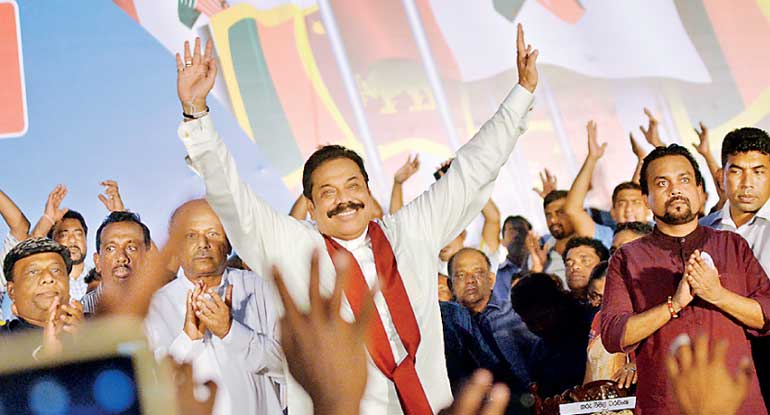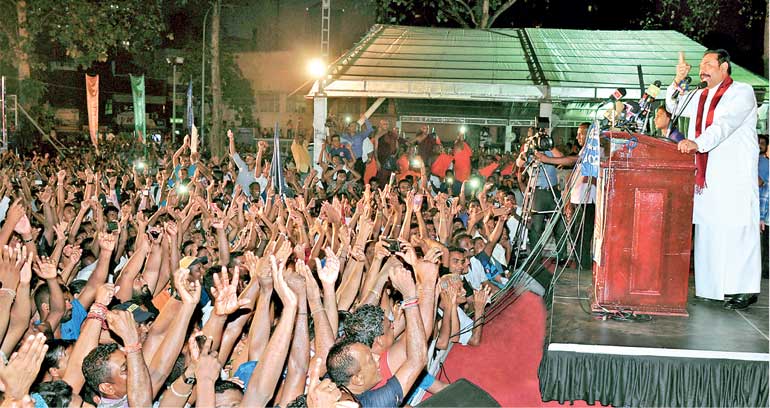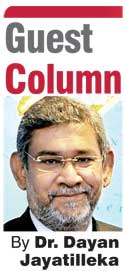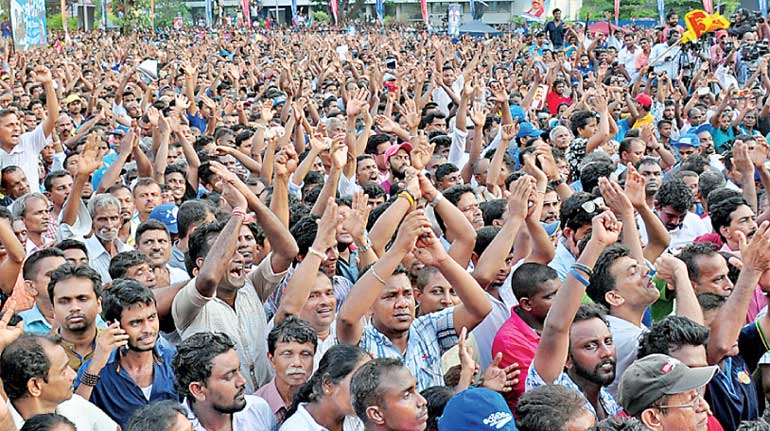Thursday Mar 06, 2025
Thursday Mar 06, 2025
Tuesday, 22 March 2016 00:07 - - {{hitsCtrl.values.hits}}
After Hyde Park, 17 March 2016, politics cannot go on as before. Not for much longer anyway.
For a few months now, Prof. Kumar David, a literate leftist and an ideologue of the Yahapalana bloc, has strenuously urged in his columns that the UNF (and its cosmopolitan left allies) “smash the Rajapaksas on the streets”. Luckily for the UNF, it chose to ignore that advice or else it would have been a case of “Bambi meets Godzilla”, with the UNF playing Bambi.
Just how ludicrous the Prime Minister’s exuberant threats to take to the streets in March was, became evident with the modest display the UNF put up in Colombo, a hub of UNP strength, on 16 March, when the numbers were insufficient to hold a public meeting at Hyde Park and the governing party settled for a few speeches at the Lipton Circus which is the usual venue for trade union picket lines.

The footage of Ranil Wickremesinghe viewing his troops while standing in the crowd, arms folded and tight lipped, was in complete contrast to the ebullience of Mahinda Rajapaksa and the view from his vantage point at Hyde Park the next day.
The crowd at Hyde Park was bigger than Nugegoda and Nugegoda was big. I know, not only because I was seated on both platforms, but also because I was a boyhood veteran of Hyde Park rallies in the 1960s and ’70s, after which my father would repair to the bar on the top floor of the building opposite (now the APIIT) and discuss the rally with Left orators such as Vajira Pelpita. I recall Wijeweera’s famous Hyde Park meeting of early 1971, where he wore a red polo-neck and demonstrated karate moves. That large meeting was a mere fraction of the crowd that packed the place and its environs on 17 March. As overhead shots showed, the Hyde Park crowd stretched up to the ODEL roundabout and down most of Union Place. The crowd was so densely packed that ex-President Rajapaksa and those on the stage were tossing their bottles of water to those in difficulty just in front of them.
The huge audience was strongly determined. It was multiclass, ranging from the underprivileged to white collar workers, professionals and managers. If this isn’t a mass movement, I don’t know what is.

Popular political movement
This is a popular political movement whose leadership clearly showed that it will not be intimidated. It dared the Government to do its worst, be it in the form of sackings or incarceration.
Hyde Park was not an ingathering of merely a nationalist, still less an ultra-nationalist tribe. Though it is at its existential core a nationalist resistance movement, a quintessentially patriotic opposition, the ideology or self-image of the mobilisation was best exemplified in SLFP senior Kumar Welgama’s declamation that the ultimate aim of the struggle was to form a “vamay aanduwak” i.e. “a government of the Left”.
This reference by an SLFP moderate centrist of long standing establishes a continuity with the bedrock SLFP tradition of 65 years: a perception of the UNP as the Right, the SLFP and its allies as “the progressive forces” – broadly speaking “the Left” – and the struggle as “Right vs. Left”, “reactionary vs. progressive”, “pro-imperialist vs. patriotic anti-imperialist”. In the SLFP’s discourse and the country’s larger political culture itself, the Centre-Left is by definition “patriotic/nationalist” and vice versa. The current UNP–driven bipartisan bloc goes against that grain.
The Hyde Park mobilisation is also a political movement that is on the offensive (or as the Americans say “on the offence”). Its discourse revealed its intention and goal: the removal of the UNP Government of Prime Minister Ranil Wickremesinghe. This did not necessarily mean overthrow and left room for its replacement by an SLFP-dominated government of a coalitional character.
The Joint Opposition has arrived
How on earth does the UNP leadership hope to implement painful IMF cutbacks, push through devolution beyond the 13th Amendment, cooperate in a Hanuman bridge connecting Tamil Nadu with northern Sri Lanka, sign ECTA which opens our IT sector  to the neighbouring behemoth, and set up special laws and special courts with foreign participation to try those who fought and won the war, when standing against it is a strong, motivated opposition movement with a formidable political leadership?
to the neighbouring behemoth, and set up special laws and special courts with foreign participation to try those who fought and won the war, when standing against it is a strong, motivated opposition movement with a formidable political leadership?
Any single one of those measures could trigger a storm of protest within and outside Parliament. The only way out is a consensual process based on roundtable discussion and collective deliberation, with buy-in by all major stakeholders including the Joint Opposition.
Hyde Park showed that the Joint Opposition has arrived, entrenched itself. It is the real Opposition and politics is polarised between the UNP Government of Prime Minister Wickremesinghe and the Joint Opposition. There was repeated reference to the respected Dinesh Gunawardena as the leader of the Joint Opposition, while Mahinda Rajapaksa is clearly the magnetic national leader of the movement as a whole.
Never has an elected Government in this country evoked as much opposition so soon – with a single significant exception. A year after it was elected in 1952, the UNP government faced the mass uprising – the ‘Hartal’ – of August 1953. That peaceful upheaval caused the UNP Cabinet to be evacuated on board a US warship. It was a double whammy, in which the body blow of a popular protest was followed in three years by a gale force electoral defeat. That UNP administration blundered on three fronts: socioeconomic (food prices), nationalism and culture (language issues, the ‘purple brigade’) and foreign policy (Bandung). A key ideologue and strategist of that disastrous UNP government was the present Prime Minister’s father. Today’s UNP administration is a throwback to that earlier anomalous experiment.
Changing the UNP’s profile
If anything is likelier than any other, it is that the present UNP Government will be defeated at the next national-level election unless it changes its profile by changing its leadership. However, unlike in 1988 it has no front-ranking organically UNP nationalist figure within its ranks. This lends itself to an outcome similar to 1956 and 1970, rather than to a last minute comeback under a new leadership as in 1988.
To my mind the more crucial question is whether or not such an electoral outcome will be preceded by the kind of upheaval that UNP governments other than D.S. Senanayake’s always faced: August 1953, 1966-68, and 1987-88. Of the three episodes, the UNP survived at the nearest election only in ’88, but that was a radically populist-patriotic UNP candidacy. The social, economic, ethnic and external profile of today’s UNP administration puts it on a collision course with the strong, dynamic, highly motivated populist-patriotic Opposition movement that was visible at Hyde Park on 17 March. This UNP looks headed straight for a hartal ’53, to be followed by an electoral 1956 a few short years down the road. Ironically, the UNP and its patrons were boasting of an Arab Spring in South Asia. Now, it may be about to get one right in the face.
This UNP Government cannot count on the military (with or without the penny packets of SF loyalists) to counter the social power of the people, not least because of the Jagath Dias and Chagi Gallege moves, the impending special courts on war crimes, the de facto No Fly Zone in the north, the installation of the TNA as the Opposition, the backstroke in relation to Tamil Nadu fishing piracy and the prospect of a constitutional federalisation process.
Ranil Wickremesinghe is the Prime Minister but Mahinda Rajapaksa is the President of the streets. The UNP leads the Government but the Joint Opposition holds ‘people’s power’. The UNP proposes from above; the Joint Opposition disposes from below. It is a classic situation of ‘dual power’.
In this situation of ‘essential equivalence’ in the balance of forces, President Sirisena must decide. Does he pivot towards or away from the anti-Ranil/anti-UNP forces? If he doesn’t halt the present course of the Wickremesinghe Government and recompose it in a manner that the SLFP is the dominant or at least the equal partner of the coalition, drawing the forces of the Joint Opposition with it, then there will be gridlock at best and collision at worst. If the present Wickremesinghe administration is not changed from above by the President, then it will be changed from below by the people. It cannot proceed on its present course.

Discover Kapruka, the leading online shopping platform in Sri Lanka, where you can conveniently send Gifts and Flowers to your loved ones for any event including Valentine ’s Day. Explore a wide range of popular Shopping Categories on Kapruka, including Toys, Groceries, Electronics, Birthday Cakes, Fruits, Chocolates, Flower Bouquets, Clothing, Watches, Lingerie, Gift Sets and Jewellery. Also if you’re interested in selling with Kapruka, Partner Central by Kapruka is the best solution to start with. Moreover, through Kapruka Global Shop, you can also enjoy the convenience of purchasing products from renowned platforms like Amazon and eBay and have them delivered to Sri Lanka.
Discover Kapruka, the leading online shopping platform in Sri Lanka, where you can conveniently send Gifts and Flowers to your loved ones for any event including Valentine ’s Day. Explore a wide range of popular Shopping Categories on Kapruka, including Toys, Groceries, Electronics, Birthday Cakes, Fruits, Chocolates, Flower Bouquets, Clothing, Watches, Lingerie, Gift Sets and Jewellery. Also if you’re interested in selling with Kapruka, Partner Central by Kapruka is the best solution to start with. Moreover, through Kapruka Global Shop, you can also enjoy the convenience of purchasing products from renowned platforms like Amazon and eBay and have them delivered to Sri Lanka.